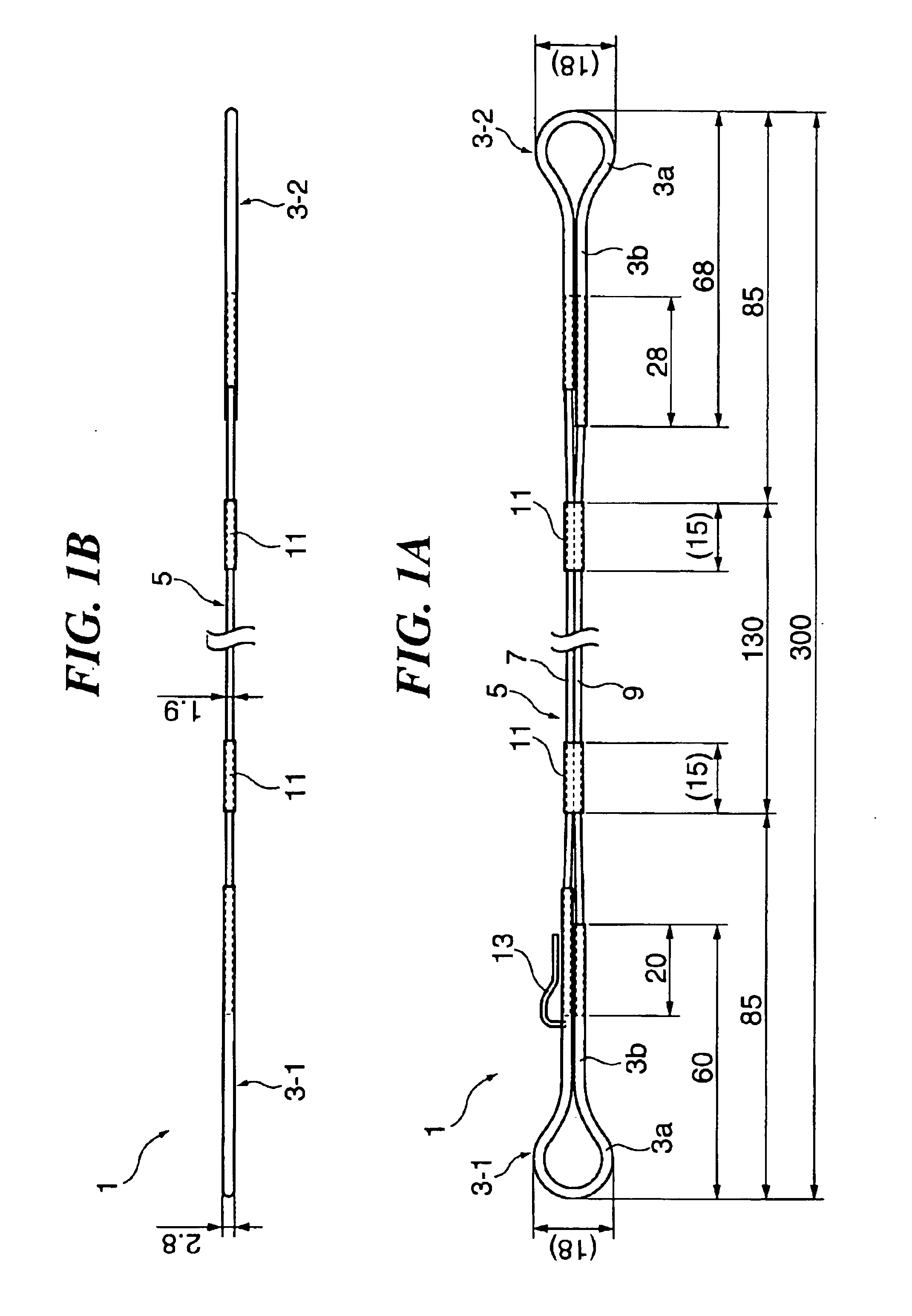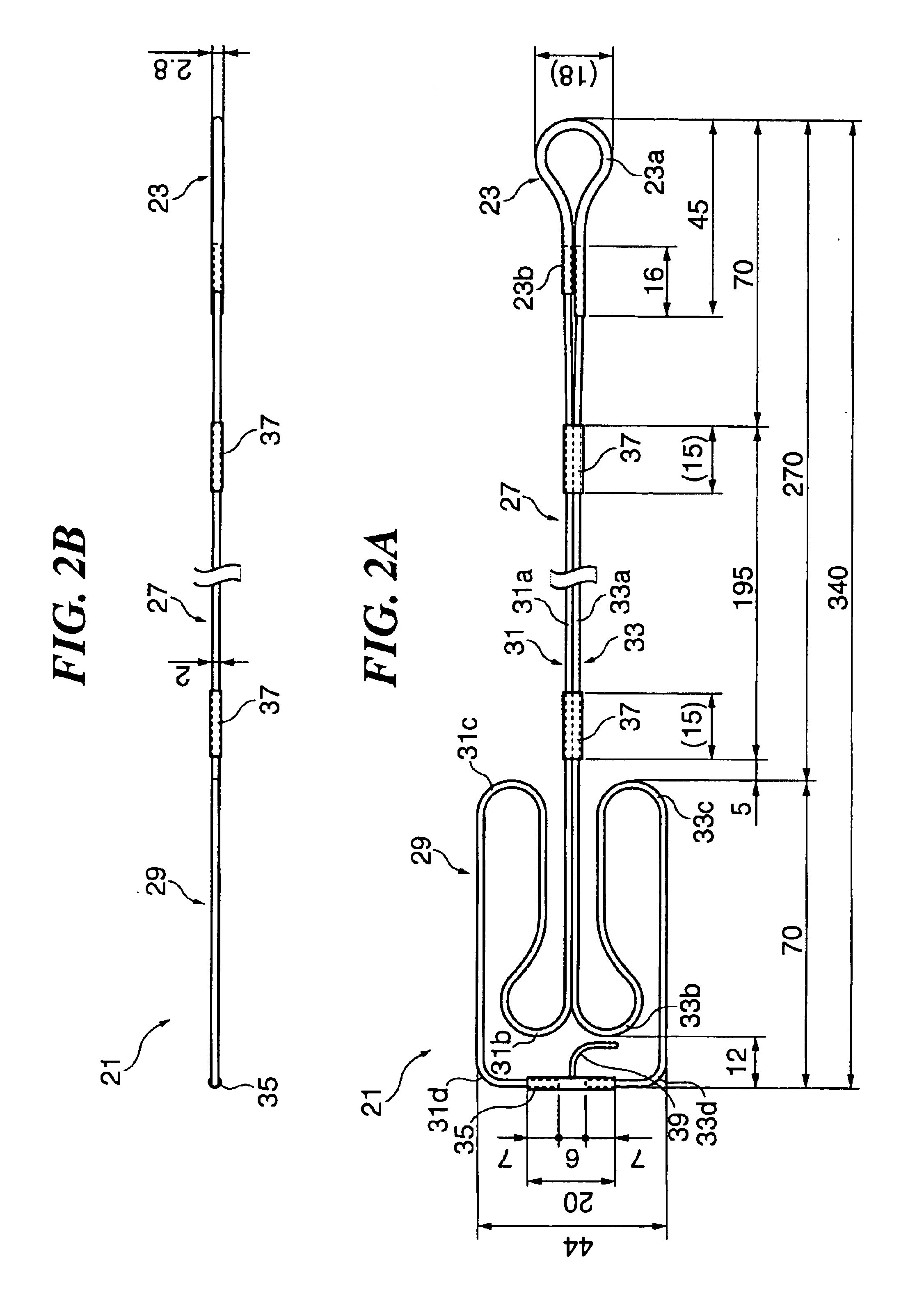Capillary tube heat pipe and temperature controlling apparatus
a technology of capillary tubes and heat pipes, applied in the direction of insulated conductors, cables, semiconductor/solid-state device details, etc., can solve the problems of not being able to describe, achieve improved heat transportable distance, prevent the damage of the peltier element, and improve heat transportable capacity
- Summary
- Abstract
- Description
- Claims
- Application Information
AI Technical Summary
Benefits of technology
Problems solved by technology
Method used
Image
Examples
first embodiment
[0041]FIG. 1 is a drawing showing a structure of a capillary tube heat pipe according to the present invention, FIG. 1(A) is a plan view and FIG. 1(B) is a side view. The sizes to be hereinafter described are examples.
[0042]This capillary tube heat pipe 1 is provided with two turn portions (a heat receiving portion and a heat radiating portion) 3-1 and 3-2 at the both ends thereof and a straight portion (a heat transfer portion) 5 extending between the both turn portions 3, and has a closed loop structure in which both terminals of a single pipe are communicated. The both turn portions 3-1 and 3-2 are made of high heat conductive material, such as copper.
[0043]Each of the turn portions 3 is made from a pipe having a length of 140 mm, an outer diameter of 2.8 mm and an inner diameter of 2.1 mm. The pipe is bent into a substantially circle shaped loop 3a having a diameter of 18 mm at an approximate center thereof. A proximal part 3b of the loop 3a is made from the straightly and adjac...
second embodiment
[0048]FIG. 2 is a drawing showing a structure of a capillary tube heat pipe according to the present invention, FIG. 2(A) is a plan view and FIG. 2(B) is a side view.
[0049]The capillary tube heat pipe 21 has a substantially same structure as that of the heat pipe 1 shown in FIG. 1 except for a structure of one of the turn portions.
[0050]The capillary tube heat pipe 21 is provided with one turn portion 23 in the right end, a meandering turn portion 29 in the left end, and a straight portion 27 which connects both turn portions, and has a closed loop structure in which both terminals of a single pipe are communicated.
[0051]The one turn portion 23 is made from a pipe having a length of 100 mm, an outer diameter of 2.8 mm and an inner diameter of 2.1 mm. The pipe is bent into a substantially circle shaped loop 23a having a diameter of 18 mm at an approximate center thereof. A proximal part 23b of the loop 23a is made from the straightly and adjacently extending parts of the pipe. The on...
third embodiment
[0058]FIG. 3 is a drawing showing a structure of a capillary tube heat pipe according to the present invention, FIG. 3(A) is a plan view and FIG. 3(B) is a side view.
[0059]FIG. 4 is a partially cross sectional view showing the capillary tube heat pipe of FIG. 3.
[0060]The capillary tube heat pipe 41 is provided with two bosses (heat conductive members) at the both turn portions 3-1 and 3-2 of the capillary tube heat pipe 1 of FIG. 1. In FIG. 3, each member having a same structure and action as that of the capillary tube heat pipe of FIG. 1 is shown with the same numeral as that of FIG. 1 and explanation is omitted. And, in FIG. 3, the tape 11 is omitted. Also, the heat pipes 1 in FIG. 1 and the heat pipe 21 in FIG. 2 may have no tapes 11 and 37, respectively. The size of each member and part is similar with that of FIG. 1.
[0061]At both turn portions 3-1 and 3-2, bosses (heat conductive members) 45 are mounted, respectively. Each boss 45 is made of high heat conductive material, such ...
PUM
 Login to View More
Login to View More Abstract
Description
Claims
Application Information
 Login to View More
Login to View More - R&D
- Intellectual Property
- Life Sciences
- Materials
- Tech Scout
- Unparalleled Data Quality
- Higher Quality Content
- 60% Fewer Hallucinations
Browse by: Latest US Patents, China's latest patents, Technical Efficacy Thesaurus, Application Domain, Technology Topic, Popular Technical Reports.
© 2025 PatSnap. All rights reserved.Legal|Privacy policy|Modern Slavery Act Transparency Statement|Sitemap|About US| Contact US: help@patsnap.com



